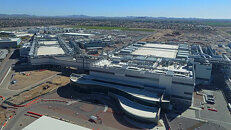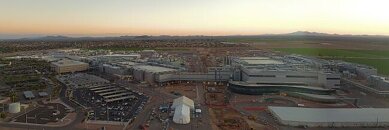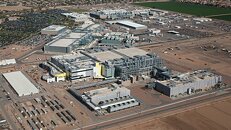Raevenlord
News Editor
- Joined
- Aug 12, 2016
- Messages
- 3,755 (1.24/day)
- Location
- Portugal
| System Name | The Ryzening |
|---|---|
| Processor | AMD Ryzen 9 5900X |
| Motherboard | MSI X570 MAG TOMAHAWK |
| Cooling | Lian Li Galahad 360mm AIO |
| Memory | 32 GB G.Skill Trident Z F4-3733 (4x 8 GB) |
| Video Card(s) | Gigabyte RTX 3070 Ti |
| Storage | Boot: Transcend MTE220S 2TB, Kintson A2000 1TB, Seagate Firewolf Pro 14 TB |
| Display(s) | Acer Nitro VG270UP (1440p 144 Hz IPS) |
| Case | Lian Li O11DX Dynamic White |
| Audio Device(s) | iFi Audio Zen DAC |
| Power Supply | Seasonic Focus+ 750 W |
| Mouse | Cooler Master Masterkeys Lite L |
| Keyboard | Cooler Master Masterkeys Lite L |
| Software | Windows 10 x64 |
Intel has finally sounded the "full steam ahead" whistle for its Fab 42, set in Arizona. Fab 42 has a storied past to it, as Intel started its construction back in 2011. It was actually finished by 2013, and by 2014 all essential infrastructure for semiconductor fabrication was there - except for the fabrication equipment itself. You see, Intel aimed for this factory to produce 450 mm wafers (instead of the industry standard 300 mm) in the 14 nm process. However, back in 2014, Intel wasn't sure about demand for its 14 nm products - and the company was actually planning to debut 10 nm back in 2016, so it sort of made sense. Of course, then came the 10 nm delays, the 14 nm supply issues, and backporting of certain products to other less cutting-edge processes. If only Intel had had a crystal ball.



Then came the 7 nm decision; Intel announced, back in 2017, that it was investing a cool $7 billion to populate the maligned Fab 42 with 7 nm fabrication equipment. But then, of course, 10 nm kept slipping, and with it, 7 nm as well; and years of constrained production on 14 nm meant demand for Intel chips was threatening to break the company's in-house fabrication philosophy dam (TSMC, where art thou?). As such, Fab 42 has been geared up for 10 nm fabrication, looking to increase output capacity to sate demand of Intel's current edge process; this places Fab 42 as Intel's third operational fab with 10 nm output (alongside its Israel and Oregon plants). Whether Intel's Fab 42 has an easy modernization path towards 7 nm production or not is uncertain - 7 nm, as Intel announces it, features both DUV (Deep UltraViolet) and EUV (Extreme UltraViolet) fabrication technologies, with EUV lacking from the current 10 nm technology. The fab will be able to be upgraded to newer fabrication tech, of course; it just remains to be seen how easy that actually is for the company.
View at TechPowerUp Main Site



Then came the 7 nm decision; Intel announced, back in 2017, that it was investing a cool $7 billion to populate the maligned Fab 42 with 7 nm fabrication equipment. But then, of course, 10 nm kept slipping, and with it, 7 nm as well; and years of constrained production on 14 nm meant demand for Intel chips was threatening to break the company's in-house fabrication philosophy dam (TSMC, where art thou?). As such, Fab 42 has been geared up for 10 nm fabrication, looking to increase output capacity to sate demand of Intel's current edge process; this places Fab 42 as Intel's third operational fab with 10 nm output (alongside its Israel and Oregon plants). Whether Intel's Fab 42 has an easy modernization path towards 7 nm production or not is uncertain - 7 nm, as Intel announces it, features both DUV (Deep UltraViolet) and EUV (Extreme UltraViolet) fabrication technologies, with EUV lacking from the current 10 nm technology. The fab will be able to be upgraded to newer fabrication tech, of course; it just remains to be seen how easy that actually is for the company.
View at TechPowerUp Main Site





